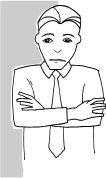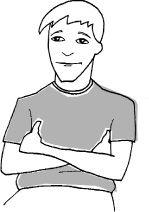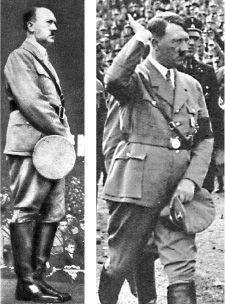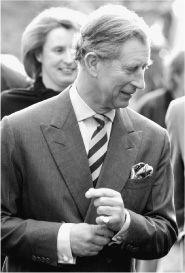The Definitive Book of Body Language (16 page)
Read The Definitive Book of Body Language Online
Authors: Barbara Pease,Allan Pease

Fists-Clenched-Arms-Crossed shows a hostile attitude exists
The Double-Arm-Grip is characterized by the person's hands tightly gripping their upper arms to reinforce themselves and avoid exposure of the front of the body Sometimes the arms can be gripped so tight that the fingers and knuckles can turn white as blood circulation is cut off. It's a person's way of comforting himself with a form of self-hugging. Arm-gripping is commonly seen in doctors' and dentists' waiting rooms or with first-time air travelers who are waiting for liftoff. It shows a negative, restrained attitude.

The Double-Arm-Grip: feeling insecure and not buying what you're selling
In a courtroom, the claimant may be seen using a Fists-Clenched-Arms-Crossed pose while the defendant may have taken the Double-Arm-Grip position.
Status can influence arm-folding gestures. A superior type can make his superiority felt by
not
folding his arms, saying, in effect, “I'm not afraid, so I'll keep my body open and vulnerable.” Let's say, for example, that at a company social function, the general manager is introduced to several new employees. Having greeted them with a Palm-Down handshake, he stands back from them—a yard away—with his hands by his sides or behind his back in the Prince Philip Palm-in-Palm position (superiority), or with one or both hands in his pocket (noninvolvement). He rarely folds his arms across his chest so as not to show the slightest hint of nervousness.
Conversely, after shaking hands with the boss, the new employees may take full or partial arms-crossing positions because of their apprehension about being in the presence of the company's top person. Both the general manager and the new employees feel comfortable with their respective gesture clusters as each is signaling his status, relative to the other. But what happens when the general manager meets a young, up-and-coming male who is also a superior type and who may even signal that he is as important as the general manager? The likely outcome is that, after the two give each other a dominant handshake, the younger executive may take an arms-folded gesture with both thumbs pointing upward.

Thumbs-Up: defensive, but he still thinks he's pretty cool
This gesture has the arms-crossed plus both thumbs up showing that he's feeling “cool” and in control. As he talks, he gestures with his thumbs to emphasize points he is making. As we've already discussed, the Thumbs-Up gesture is a way of showing others we have a self-confident attitude and the folded arms still give a feeling of protection.
Someone who is feeling defensive but also submissive at the same time will sit in a symmetrical position, which means one side of their body is a perfect mirror of the other. They display tense muscle tone and look as if they expect to be attacked, whereas a person who is feeling defensive and dominant will take an asymmetrical pose, that is, one side of the body doesn't mirror the other.
When you're presenting your case to someone and the Thumbs-Up-Arms-Crossed appears toward the end of your presentation and is clustered with other positive gestures, it signals you can move comfortably into asking the person for a commitment. On the other hand, if at the close of the presentation the other person takes the Fists-Clenched-Arms-Crossed position and has a poker face, you can be inviting trouble by attempting to get a yes. It would be better to ask questions to try to uncover the person's objections. When someone says no to a proposal, it can become difficult to change their mind without looking as if you're aggressive. The ability to read body language allows you to “see” a negative decision before it is verbalized and gives you time to take an alternative course of action.
When you can see a no before it's said,
you can try a different approach.
People carrying weapons or wearing armor seldom use arm-cross gestures because their weapon or armor provides sufficient body protection. Police officers who wear guns, for example, rarely cross their arms unless they are standing guard and they normally use the fist-clenched position to communicate clearly that nobody is permitted to pass where they are standing.
When we were children our parents or caregivers embraced or hugged us when we faced distressing or tense circumstances. As adults, we often attempt to re-create those same comforting feelings when we find ourselves in stressful situations. Rather than take a full arm-cross gesture, which can tell everyone we are fearful, women often substitute a subtler version—a Partial-Arm-Cross, where one arm swings across the body to hold or touch the other arm to form the barrier and it looks as if she is hugging herself. Partial arm barriers are often seen in meetings where a person may be a stranger to the group or is lacking in self-confidence. Any woman taking this position in a tense situation will usually claim she is just being “comfortable.”

Holding herself like her mother held her when she was a child
Men use a partial arm barrier known as Holding-Hands-With-Yourself; it's commonly used by men who stand in front of a
crowd to receive an award or give a speech. Also known as the Broken Zipper Position, it makes a man feel secure because he can protect his “crown jewels” and can avoid the consequences of receiving a nasty frontal blow.

The Broken Zipper Position
It's the same position men take in a line at a soup kitchen or to receive social-security benefits and reveals their dejected, vulnerable feelings. It re-creates the feeling of having someone else hold your hand. Adolf Hitler used it regularly in public to mask the sexual inadequacy he felt because of having only one testicle. It's possible that evolution shortened men's arms to allow them to take this protective position because when our closest primate cousins, the chimpanzees, assume the same position, their hands cross at their knees.

Humans make a point of hiding the areas they think are their weakest or most vulnerable
Their Insecurity
People who are continually exposed to others, such as royalty, politicians, television personalities, and movie stars, usually don't want their audiences to detect that they are nervous or unsure of themselves. They prefer to project a cool, calm, controlled attitude when on display, but their anxiety or apprehension leaks out in disguised forms of arm-crossing. As in all arm-cross gestures, one arm swings across in front of the body toward the other arm, but instead of the arms crossing, one hand touches or holds on to a handbag, bracelet, watch, shirt cuff, or object on or near their other arm. Once again the barrier is formed and the secure feeling is achieved.

Famous people are just as nervous in public as the rest of us
Men wearing cuff links are often seen adjusting them as they cross a room or dance floor where they are in full view of others. The Cuff-Link-Adjust is the trademark of Prince Charles, who uses it to give himself a feeling of security anytime he walks across an open space in full view of everyone.
